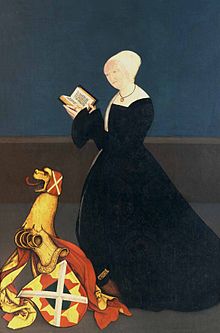Ulrich VII of Montfort-Tettnang
Count Ulrich VII of Montfort zu Tettnang or Ulrich the Younger (* before 1485; † 1520 ) was the last representative in the male line of the Counts of Montfort-Tettnang , a branch line of the Count Palatine of Tübingen .
Live and act
Ulrich VII. Was the son of Ulrich V (1440–1495). Since Ulrich married Magdalena von Oettingen-Wallerstein in 1485 in the presence of his parents , Count Ulrich must have been born before 1485. After the death of his father in 1495 he took over the business of government and devoted himself to the expansion of Tettnang , which had already become the capital of the county. With the consolidation of the role of a citizens' council, the mayor and the ammann , he stabilized the city's self-government. Interested in art and therefore highly respected by the nobility, he created the gate lock and the parish church of St. Gallus and came out as the client of Bernhard Strigels . Emperor Maximilian I paid tribute to the cultural boom with visits in 1499 and 1516.
Together with his wife Magdalena von Oettingen-Wallerstein, he donated the St. Anna Chapel in Tettnang in 1513. The construction of the new chapel and the election of the patroness were linked to the wish of the donor couple for another child blessing. Magdalena had already given birth to nine children, but the two sons had died early and the seven daughters were not entitled to inheritance. The decoration of the chapel with the coat of arms of the ancestors refers to the motivation of the foundation: Intercession for the continued existence of the Count's house of Montfort.
After the death of Ulrich VII, something special occurred: his widow Magdalena von Öttingen, who is described as emancipated, held the position of city regent for six years. She married Johann I. zu Rothenfels , the last living cousin of her deceased husband. Since there was still no successor, both of them took on his three nephews. After her death, Emperor Charles V enfeoffed her nephew Hugo XVI by marriage. with Tettnang, who thus established the Tettnang-Rothenfels-Tettnang line.
literature
- Johann Nepomuk von Vanotti : History of the Counts of Montfort and of Werdenberg. A contribution to the history of Swabia, Graubünden, Switzerland and Vorarlberg. Belle-Vue near Konstanz 1845, pp. 140–141 Google digitized
Notes and individual references
- ^ Förderkreis Heimatkunde Tettnang: Counts of Montfort.
- ^ Genealogy of the von Oettingen family
- ↑ Support group Heimatkunde Tettnang: St. Anna Chapel.
- ↑ Gothic altar wings return to St. Anna. Schwäbische Zeitung, July 23, 2010.
- ↑ Legend has it that she berated her husband violently when he tried to forcibly marry their daughter.
- ^ Roland Weiss: The Counts of Montfort-Tettnang in the 16th century . Diss. 1992, p. 10f.
| personal data | |
|---|---|
| SURNAME | Ulrich VII of Montfort-Tettnang |
| ALTERNATIVE NAMES | Ulrich VII the Younger from Montfort-Tettnang, Count Ulrich VII from Montfort zu Tettnang |
| BRIEF DESCRIPTION | Last male name bearer of the house of Montfort-Tettnang |
| DATE OF BIRTH | before 1485 |
| DATE OF DEATH | 1520 |
| Place of death | unsure: Tettnang |

